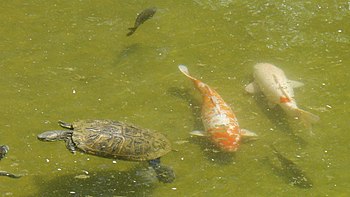 |
| Duchesnea indica, invasive species, in the "Wood of Citadelle" (Photo credit: Wikipedia) |
This poses a unique problem to many hobbyists…what exactly do I do with my aquatic plant/animal that I cannot care for? With the help of this wonderful thing that eats up most of my day (the internet, for you non-it people that actually work) I’ll try to cover some of the basics here…
Plants
Let’s say that John Q. Aquarist has an overabundance of a particular aquatic plant. “Whatever will I do with all of these plants?” John wonders. Well, there are a number of ways to safely dispose of these potentially invasive species, here are a few:
Burning: If allowed in your area, can be an excellent way of disposing of plants that have seeds.
Freezing or Drying: This will effectively destroy plants, but might allow seeds to survive. You can place them in a zipper-type plastic bag and throw them away after this.
Composting: Like freezing or drying, this will also do the job of destroying the plant, but seeds can potentially survive to be carried off by birds or animals that might ingest the seeds.
Animals
John Q. Aquarist got up this morning and discover that his tank contained a huge batch of baby platies. “Ruh roh, what I’m going to do now? My tank can’t support this many fish!” John laments. Don’t worry, John, there is a help!
Friends: If you have a friend that is into the wonderful world of fish keeping, perhaps he’d like some little guys. Use your head though: if he or she would like to have them, make sure you let your friend know the particulars about the species…it will just put your pal in the same position if he or she is not prepared.
LFS: If your LFS is like mine, they will take your unwanted pets…sometimes for a trade, sometimes not. Either way, it’s better than euthanizing or flushing. (Flushing is particularly cruel...a slow death is guaranteed by suffocation or poisoning)
Whatever you decide to do, never release them into the wild! Aquatic plants and animals could introduce diseases that the native population is not prepared for. At best, some species can out-compete the natives.
Some states have penalties for improper disposal of aquatic life. I hope this helps to answer some questions and prevent any unfortunate incidents.
If you have anything to add, by all means, do. In no way do I consider this definitive, so let’s see some other opinions!
(Remember, you can always contact your local Department of Natural Resources or Health Department for specific information for your area)








